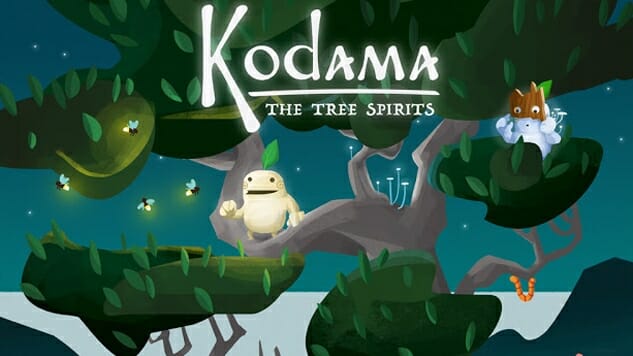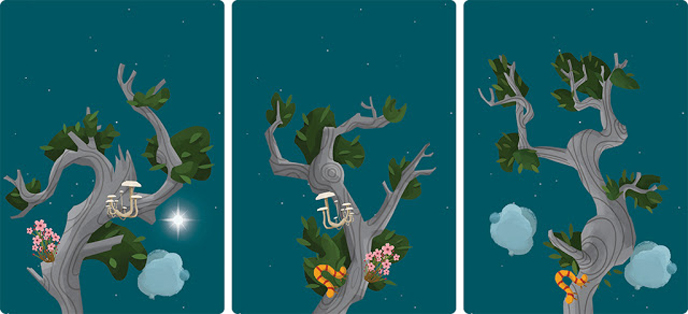
I’m pretty sure Kodama: The Tree Spirits is the cutest game I own, and I mean that as a compliment. There’s clearly a benefit to a creating a game that’s so visually appealing that it makes folks want to play it. Its cute aesthetic is thoroughly worked into every facet of the game, from its theme all the way down to its gameplay, as players grow trees to please the alien child-like spirits of the forest.
Each player in Kodama starts with a large card showing a tree trunk with one of the game’s six “features” on it. Over the course of three seasons (spring, summer, and fall, because in winter everything dies, or so I assume), players will add twelve branch cards that show three or four features on them, trying to score points by creating chains of branch cards bearing the same features. You score a point for every time a feature appears in the chain back toward the trunk, including the trunk card, as long as the chain of that feature is unbroken. For example if you place a card with a mushroom on it and have it attached to a branch card with another mushroom, but the card beyond that doesn’t have one, you get two points, even if further down the chain there are more mushrooms on cards.
At the end of each season, there’s an additional scoring step, where each player gets to play a Kodama card that awards points for certain conditions on the tree. For example, four points are awarded for every branch card attached to your trunk, or two points for every time the feature on your trunk card appears on cards at the far ends of your branches. Those cards are unique to players; you are given four to start the game and will play three before it’s done, so thinking about which cards you might use and when is a critical decision, and will alter what branch cards you might play and whether you’ll try to build two long branches or three to five shorter ones.
The enormous number of variations on how you place branch cards gives Kodama plenty of replay value, and the game adds to that further with 15 season “decree” cards that introduce small tweaks to the rules or new scoring opportunities to each season (also creating an obvious place for future promo cards or expansions). Most of these are minor, but there’s one for the final season that significantly changes game play. The standard rules limit players to moves that score a maximum of ten points (if placing a branch would earn you more than that, you can’t place it). However one Fall decree card changes that to twelve points. While you can’t see any season decree card until the previous season has ended (meaning you won’t be able to plan ahead for it), the player best set up to take advantage of that one card can garner a large advantage in the final round.
One of Kodama’s most endearing features is the path of the trees, which don’t have to follow any specific pattern or shape. You can attach a branch to the trunk card or to another branch card at any angle, covering a little or a lot of the card already on the table, as long as you’re touching the drawing of the branch on one card to the drawing on the other, and the new card doesn’t overlap or touch a second card. I wouldn’t quite call it art, but there’s a reward for creativity here that isn’t present in most boardgames.
Overall Kodama is highly balanced, thanks both to its ten-point scoring limit and its policy of making the lowest scoring player start first. However there are certain Kodama card combinations that offer strategic edge to the players who collect them. In one of our many plays, I landed two cards that reward the player for having certain branch cards attached to their trunk card, awarding 20 and 16 point bonuses in successive seasons and allowing me to win the game in a rout. It swung things in my favor so much that the developers should maybe consider making a house rule to avoid that specific card pairing, or any two Kodama cards that are so similar that the player essentially gets to hit the same bonus twice.
Kodama is for two to five players, although I haven’t tried it with five people; we found games took 30-40 minutes, and the rules are simple enough for kids to understand as long as an adult helps them place their branch cards correctly. At a list price of under $20, it’s a steal, and even better if you play it while listening to the (unrelated) album of the same title, a record by French shoegaze/metallers Alcest, which happened to be my favorite metal album of 2016.
Keith Law is a senior baseball writer for ESPN.com and an analyst on ESPN’s Baseball Tonight. You can read his baseball content at search.espn.go.com/keith-law and his personal blog the dish, covering games, literature, and more, at meadowparty.com/blog.

